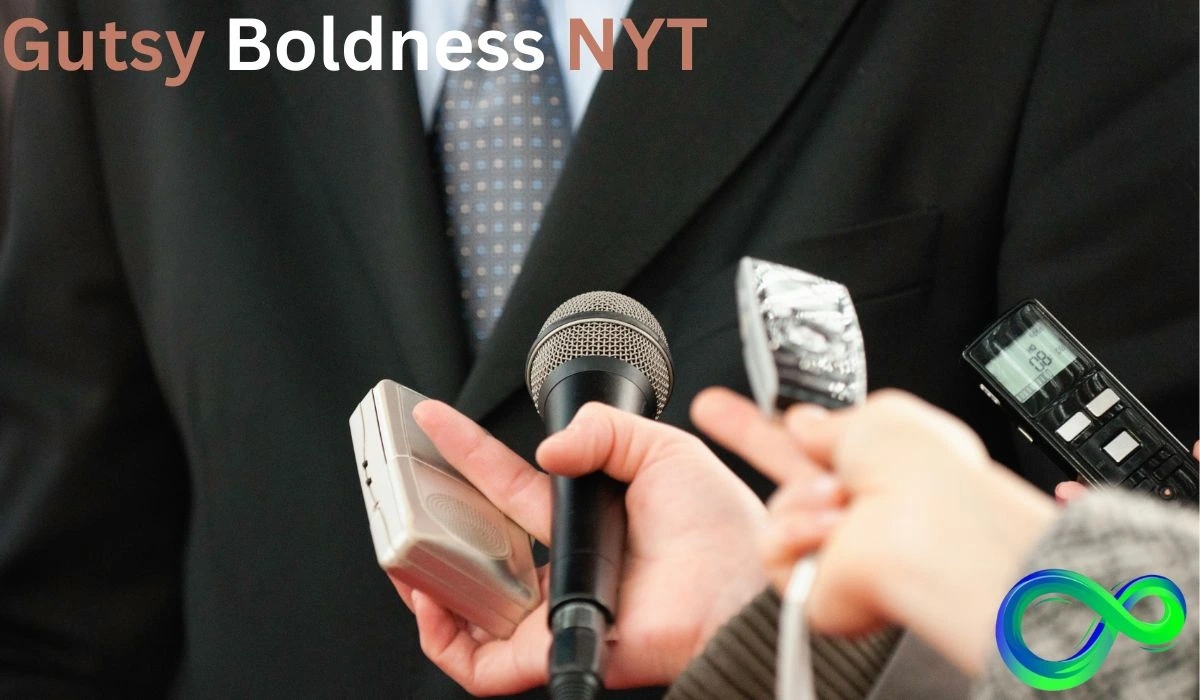Gutsy Boldness NYT: Understanding the Essence of Courageous Reporting
In journalism, the word “gutsy boldness” has a strong emotional connection with people who are looking for accountability and the truth. One of the most prestigious newspapers in the world, The New York Times (NYT), continually demonstrates that it is dedicated to reporting without fear and frequently exhibits the spirit of audacity.
Its coverage of difficult subjects, constant search for the truth, and bravery in writing articles that elicit strong feelings and public discussion are all examples of this tactic. The ideal of taking chances and continuing in the face of difficulty appears in “gutsy boldness NYT.”
Also read:
State Class None and Device Class Volume
Where is Tabathin Plains Located at TOTK?
What is Gutsy Boldnessin Journalism?
In journalism, gutsy boldness is the bravery to take on difficult subjects, often at the expense of oneself or the company in question. This entails reporting on stories that could be divisive, politically delicate, or even risky for the NYT. It calls for a strong feeling of duty of care, moral rectitude, and bravery.
Investigating big companies, exposing fraud by the government, or questioning social norms are just a few examples of the NYT’s history of reporting with gutsy daring. The NYT term “gutsy boldness” is a byword for journalistic bravery and the relentless search for the truth despite every barrier.
Hallmarks of Gutsy Reporting at the NYT
- Fearless Investigations: Fearless investigations uncover hidden truths, holding power accountable. With unwavering determination, journalists dig deep into corruption and injustice, risking backlash to inform the public and drive meaningful change.
- Unyielding Integrity: Unyielding integrity is the commitment to uphold strong ethical principles, consistently making decisions based on honesty, transparency, and accountability, regardless of external pressures or challenges, ensuring trust and reliability in every action.
- Impact-Driven Journalism: Impact-driven journalism focuses on producing stories that spark social change, hold power accountable, and inspire action. It emphasizes truth, responsibility, and the ability to influence public discourse and decision-making.
Key Principles of Gutsy Reporting
- Truth over Consequences: Truth over Consequences” means prioritizing honesty, even when the truth is difficult or uncomfortable, recognizing that integrity is more valuable than the potential risks or backlash that may follow.
- Public Interest First: Public Interest First, Truth over Consequences” means prioritizing the public’s right to know, even when it involves risks or backlash, ensuring that truth, transparency, and accountability come before personal or organizational consequences.
- Balancing Risk and Responsibility: Balancing risk and responsibility involves making informed decisions that weigh potential dangers against obligations. It requires careful analysis, accountability, and foresight to ensure responsible action while minimizing negative outcomes.
Historical Examples of Gutsy Boldness by the NYT:
The New York Times has a long history of reporting with fearless audacity. Its coverage of the Pentagon Papers in the 1970s is one noteworthy instance. An important display of bravery and audacity was the NYT’s decision to release classified documents that showed the US involvement in the Vietnam War.
Given the possibility of legal disputes and opposition from the government, this decision was not taken lightly. Nonetheless, the NYT demonstrated the true meaning of fearless audacity by putting the public’s right to know ahead of any potential consequences.
The NYT’s investigative reporting on the Weinstein family and the #MeToo movement serves as another illustration. Despite possible criticism, the choice to release articles outlining claims against a significant Hollywood mogul showed a dedication to accountability and the truth.
This act of daring audacity NYT was important in launching a global discourse on sexual harassment and assault, emphasizing the immense influence that gutsy news can have on society.
The Role of Gutsy Boldness in Modern Journalism
Bold bravery is more important than ever in the current digital era, where sensationalism and false information are rife. By tackling topics like social justice and government fraud the New York Times is upholding its legacy of fearless reporting.
NYT’s use of the phrase “gutsy boldness” serves as a reminder of the value of brave journalism in exposing injustices and giving the public access to true, unfiltered facts.
The NYT’s coverage of modern themes including racism, climate change, and international wars demonstrates its dedication to courage. These subjects often require striking a careful balance between educating the public and negotiating intricate political and social environments.
In a time when media integrity is regularly questioned, the journal makes sure it retains its reputation as a reliable information source by showing bold audacity.

Challenges Faced by Gutsy Journalists at the NYT
When bold audacity is praised, it is not without its difficulties. Journalists at the New York Times often endure important dangers, like legal threats, pressure from politicians, and physical harm.
Reporters must be ready to defend what they write despite intimidation or attempts to discredit them because of NYT’s dedication to gutsy bravery. This tenacity is proof of the bravery and commitment of the NYT staff, insuring the survival of the values of fearless journalism.
Also, the NYT’s bold audacity has become more complicated because to the growth of social media and digital media. A sophisticated approach is required to maintain journalistic integrity while being daring in an era where public opinion can be quickly changed and news spreads quickly. The NYT deals this landscape by upholding strict fact-checking procedures, offering fair views, as pledging to be open and honest with its readers.
Gutsy Boldness in an Evolving Media Landscape
Gutsy boldness in the evolving media landscape reflects fearless reporting, challenging norms, and embracing new platforms. Journalists today must balance innovation with integrity, reshaping how stories impact and engage audiences.
Social Media and Its Influence
The advent of social media has reshaped how stories are shared and received. For the NYT, this means:
- Engaging Directly with Audiences:
- Combatting Misinformation: Combatting misinformation requires fact-checking, media literacy, and responsible journalism. By promoting accurate information, educating the public, and fostering critical thinking, we can reduce the spread of falsehoods in society.
Adapting to Changing Consumer Habits
Today’s readers demand more interactive and visually engaging content. The NYT meets this demand by:
- Innovating Storytelling:Innovating storytelling combines creativity with technology, transforming traditional narratives. It uses new mediums like virtual reality, interactive elements, and diverse formats to engage audiences in immersive, dynamic, and impactful ways.
- Interactive Reporting: Interactive reporting allows users to engage with data through dynamic visuals, filters, and real-time analysis, offering personalized insights. It enhances storytelling by making complex information more accessible and engaging.
The Impact of Gutsy Boldness on Public Perception
It is hard to overestimate the impact of bold boldness on public opinion. The New York Times reinforces its standing as a pioneer in international journalism through its dedication to daring, bold reporting.
Today, the term “gutsy boldness” describes journalism that questions authority, pushes boundaries, and challenges the status quo. Millions of readers around the world have come to trust this strategy, which has also been vital in influencing public opinion on important topics.
The NYT creates an industry-wide culture of courage and responsibility by constantly exhibiting gutsy audacity that influences how other media outlets approach their reporting. As a result, the phrase “gutsy boldness” NYT denotes not only just a media approach; it also denotes an allegiance to democratic principles and the quest of truth at any costs.
Shaping Public Discourse
The NYT’s dedication to gutsy reporting has significantly influenced global conversations. By challenging entrenched power structures and amplifying marginalized voices, the NYT sets a high standard for journalism worldwide. The term gutsy boldness NYT has become synonymous with transformative journalism that not only informs but also inspires change.
Inspiring Other Media Outlets
The NYT’s example encourages other publications to adopt a similar ethos of courage and accountability. This ripple effect fosters a media environment where bold reporting is celebrated and emulated.
The Legacy of Gutsy Boldness at the NYT
A Tradition of Courage and Integrity
From its earliest days to the present, the NYT has championed journalism that prioritizes truth and accountability. The legacy of gutsy boldness NYT is a testament to the power of the press in upholding democratic values and protecting the public’s right to know.
Looking to the Future
As threats to press freedom continue to emerge globally, the NYT remains a beacon of fearless journalism. Its unwavering commitment to gutsy reporting ensures that future generations will continue to benefit from an informed and engaged society.

Conclusion: Gutsy Boldness NYT
Courage, integrity, and an invincible attention to the truth are hallmarks of the NYT’s daring bold custom. The New York Times is steadfast in its belief in fearless journalism even as the media landscape changes. Its stories, which are frequently published at some risk, show a profound awareness of the critical role that brave audacity plays in democracy.
The NYT’s use of the phrase “gutsy boldness” serves as a potent reminder to both readers and journalists of the value of speaking truth to power and the significant global impact that daring, brave reporting can have.
The New York Times’ drive to daring ensures that it will continue to be a beacon of truth and an ally of the public’s right to know, even if threats to press freedom continue to exist on a global scale.











